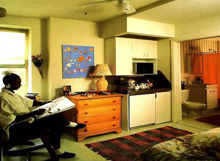- Article
- Other
Community Revitalization in Cities: Cases from Japan and the United States
February 3, 2010
The thirty-first Tokyo Foundation Forum took up the issue of community revitalization in cities, focusing in particular on cases from Japan and the United States. The speakers were Rosanne Haggerty, founder of the nonprofit organization Common Ground, and Tomohiko Okabe, CEO of Kotolab, LLC. Common Ground provides housing to homeless people, while Okabe works on revitalizing Yokohama’s Kotobukicho district, where the majority of residents live on welfare.
Common Ground restored the Times Square Hotel in New York, which had fallen into disrepair following its bankruptcy and become a hangout for homeless people and drug addicts, and made it a residential building. By providing homeless people with a home and improving the security of the neighborhood, the project has brought about positive economic effects and revitalized the community. Common Ground’s strategy for ending homelessness is now spreading to major cities across the United States as well as in Canada and Australia.
Okabe is involved in several projects in the Kotobukicho district of Yokohama. The Yokohama Hostel Village utilizes lodging houses for welfare recipients as guesthouses for backpackers and other tourists, and the nonprofit organization Sanagitachi engages in activities to benefit local welfare recipients.
The discussions by the speakers and the question-and-answer session with the audience are summarized below.
Remarks by Rosanne Haggerty
Over the past 20 years, Common Ground has provided housing to homeless people and people in need. Our focus has been on ending homelessness. We see that as very much a community development requirement and issue, because it’s our view that homelessness is a symptom of communities in distress and a warning to all of us that the web of support that we rely on in our societies is fragile.
As we become more familiar with the impact of social networks and social network theory, we’re finding that we are very much influenced by the health, prosperity, and security of people who share the environment with us. It’s not enough to just care for ourselves and for our families; for our own preservation, we have to be mindful of everyone in this web of society that we exist with.
The Times Square Hotel
This is the way we think about how to approach community revitalization and urban regeneration: It’s a combination of working with structures, with people, and with communities. We believe that we can find and see the possibility of catalytic change if we focus first on the people, structures, and communities in the most extreme need.

Common Ground started out with the Times Square project. Times Square in 1990 was known throughout the United States as being a symbol of urban blight and failure, and the Times Square Hotel on the corner of 43rd Street and 8th Avenue was believed to be the worst building in Times Square, a place where prostitution, drugs, fires, and regular criminal events had been the pattern for several years.
Our idea was to turn this property into a home for individuals who were homeless, as well as for individuals who were working in the area and needed an affordable place to live. We were able to raise the money through loans from the City of New York and from private investors to turn it into a lovely, stable home that became an asset for the neighborhood as well as a safe refuge for 652 people. On the ground floor we opened businesses that, as part of the agreement with the operators, would employ our tenants. In addition, we teamed up with a social service organization to have staff in the building who would assist tenants with their health, mental health, and employment needs. The apartments are all small one-room apartments with private baths and kitchenettes, and each tenant pays 30 percent of his or her income, so it’s affordable no matter what a person’s income is. In addition, we have worked very actively to make it a real community with many services and programs to encourage tenant leadership and involvement and to help people connect with their aspirations and build better lives.
Before the Times Square and some other projects that began at around the same time, it was very much the norm to simply open shelters, allow people to sleep on the street, and just feel that the problem of homelessness was something that we couldn’t do anything about. In fact, shelters have proven to be a very useless offering for homeless people without a long-term strategy. People need homes, not a temporary shelter.

The Times Square opened in 1994, and there are now 60,000 units of supportive housing throughout the United States. What we consistently find is that once people find a home again, they’re able to care for their health, re-establish connections with family and friends, return to the workforce, and become a proud citizen again. Nevertheless, we need to build many more supportive housing units than we already have in the United States. We still have 130,000 people every year as counted by cities who have remained homeless for a year or more. Among those who remain homeless for long periods of time, an overwhelming number are individuals with serious health, mental health, and addiction issues who need our help very urgently. Part of the tragedy of prolonged homelessness is that shelters, hospitals, psychiatric hospitals, and jails—the types of places that people end up in when they are desperate and without housing—cost so much more than providing them with a chance to be in a stable home. But this also represents a social entrepreneurial opportunity, and the best solution for ending homelessness and for investing in communities and restoring buildings is actually a less expensive option than the status quo.
We’ve discovered in more recent years that being very strategic about matching people who are homeless and have very serious needs with housing is a powerful way to reduce homelessness altogether. One of the effects of the Times Square’s success has been that, throughout New York and, in recent years, the rest of the United States and as a matter of federal policy, this approach to homelessness is becoming standard practice.
Approaching Homelessness
While there are 130,000 individuals in the United States who have remained homeless for a year or more, over two million people experience homelessness for a short period of time every year. We realized in the early 2000s that, although Common Ground built the Times Square Hotel and went on to develop many other apartments for the homeless, we were not seeing a reduction in homelessness in New York City.

We turned to our own neighborhood to try and understand how we could have a bigger impact on homelessness. We began working closely with the Times Square Business Improvement District, an entity that was dedicated to the revitalization of the Times Square community. We had worked closely with the BID on connecting property owners and social service efforts to assist homeless people, but we had never actually studied homelessness on the street until the early 2000s.
By going out day after day for weeks—early in the morning between four and six am—and documenting who was sleeping consistently in Times Square, we discovered that there were usually about 55 people on any given day. But we also realized that there was a group of 18 people who were consistently there and that the rest of the group was changing from day to day or week to week.
We began focusing on those 18 individuals who never left the streets of the Times Square area. Within a year of getting individuals from that group housed, the average number of homeless people in the area had gone from 55 to 15. And now that number is down to 7. By helping individuals who had been on the streets for the longest time in that neighborhood to move directly into their own homes, we were able to create a remarkable multiplier effect.
We came to theorize that we had discovered a whole strategy for both getting vulnerable people housed and reducing homelessness: It was all about being very specific, being focused on individuals who had been homeless the longest and were in the most vulnerable health. In our community revitalization work, we had to focus not on people generally or homeless people in the abstract, but on specific individuals who were trapped in homelessness and worse.
Since then, we have persuaded the City of New York to adopt this strategy citywide, and since September 2007, street homelessness in all of New York has been reduced 50 percent. We have also trained 19 other cities in the United States, Canada, and Australia in using this methodology. All of these cities have had dramatic results.
The Brownsville Partnership
We have taken these two experiences—of seeing a whole community in Times Square revive, in part because of our work in Times Square Hotel and with others making investments in the neighborhood, and of changing homelessness by a data-oriented strategy—and moved on to a whole new dimension. We realized that we wanted to move to an even more ambitious project and have begun in recent years to work in a neighborhood in Brooklyn, one of the lowest-income communities in New York City.
Following the set of principles that we learned in Times Square, about starting with the most challenged places, buildings, and people, we are working in an area of 4,400 apartments where the social problems are the most extreme. Our vision is to create a healthy, sustainable, and prosperous community and to link the physical redevelopment of the neighborhood with economic opportunities for the people who work there. We are working to create another 1,000 affordable apartments, all of them sustainably built, and to create jobs to lower the local unemployment rate, which is now 30 percent. We are also working on an extensive master planning process with the residents of the community to create new housing and retail and, through those two enterprises, at least 700 jobs for the community. A principal part of the plan is to retrofit and make more environmentally sustainable the 56 buildings that are part of this development.
Nationwide Expansion
As I’ve described, we’ve been training other cities that have requested our help in learning how to practice our methodology. But by looking at the data around homelessness in the United States, we realized that 50 cities represent over 65 percent of the long-term homelessness in our country. So rather than just be reactive and go to assist those cities that ask for our help, we’ve decided to go to those cities that have the largest issues around homelessness and persuade them that they need our help. We know it’s possible to reduce homelessness by 100,000 in the United States by focusing on these 50 cities. Thus far, we have 14 of the 50 cities already signed up to launch the campaign this year.
When we bring the community together—the business improvement district, social services provided by the city or state, local volunteers, people working for NGOs—and everyone focuses on constructing the city’s list of the most vulnerable people living on the street, a great sense of urgency is discovered, and people find the resources to begin providing housing and support for those in the greatest need. Not only do we see more homeless individuals being housed and lowered homelessness, but we see communities coming together and finding a new strength and capacity as they work together to solve the challenging problem of assisting the most vulnerable.
Remarks by Tomohiko Okabe
Kotobukicho in Yokohama, Kanagawa Prefecture, is a district nearby the Ishikawacho train station. It used to have many day laborers, but now half of its population of 6,500 is aged 60 years and above, 80 percent are on welfare, and over 95 percent are men. The town’s old image still sticks strongly with many people—that if you go there by car you’ll be the victim of an atariya [an accident faker who deliberately gets hit by a car to receive compensation], or that if you’re a woman you won’t be able to leave the place in one piece. Also, many of the residents are lonely people, and it’s unusual to see young people around. My take on the issue is that we might be able to change this environment in an indirect fashion by bringing in young people.
The Yokohama Hostel Village
I run a limited liability company called Kotolab, and I’m also on the board of a nonprofit organization called Sanagitachi. I’m involved in a number of projects, the first of which is a youth hostel project. There are many cheap lodging houses for day laborers in Kotobukicho; currently there are 122 lodging houses with 8,600 rooms, each the size of three tatami mats. Since the population is 6,500, that comes down to about 2,000 vacancies. So we started on the idea of utilizing these vacant rooms as lodging and getting young tourists and other new people to come to the town. This was the Yokohama Hostel Village, which we’ve been running since 2005.
These cheap lodging houses themselves are privately run, so each one has an owner. The number of lodging rooms in Kotobukicho is increasing. This is for reasons on the part of the owners, which is to say, many of these lodging houses have been rebuilt since around 2000, because old buildings don’t attract guests. When a lodging house is renewed, it gets taller, and taller means more rooms.
What we do is we work with the owners to renovate the run-down rooms and get people to move in. We now run four hostels with a total of 40 rooms. All of these hostels just make use of vacant rooms. In a building called Hayashi Kaikan, for instance, welfare recipients occupy the first to fourth floors, while the fifth floor is used as a hostel. Other owners have followed our model, renovating their lodging houses and obtaining new clients. There are now five hostels run by other owners. All in all, the number of rooms comes to about 140.
This increase in hostel numbers is having secondary effects, one of which is improved security. The police now patrols the area more frequently than before. Another effect has been that some art groups are showing an interest in Kotobukicho. In addition, we’ve been creating gardens on the rooftops of the hostels that we run, planting grass and other plants, and this has led to the greening of the town. Neighboring buildings and other lodging houses are following suit and planting greenery on their own properties.
Sanagitachi
I’m also involved in the activities of the nonprofit Sanagitachi. Sanagitachi is an organization that provides for homeless people and welfare recipients in Kotobukicho in the areas of medical care, clothing, work, food, and housing. Since we can’t practice medicine ourselves, our chairman—who is a doctor—provides medical treatment at his clinic. There are welfare companies that take part in our activities as well.
We run two facilities, the Sanagi House and Sanagi Restaurant. The Sanagi House serves as a salon for the people of the town. Since many of the townspeople are single, it provides an important forum for communication and for making friends. We also give out clothes and other daily necessities that have been donated for free.
The Sanagi Restaurant was started under the concept of a 300-yen eatery. At the time, the local government gave out “bread tickets” to people who didn’t meet the legal criteria for welfare, with which you could do 750 yen’s worth of shopping. So the idea was to offer three warm meals in exchange for one ticket, and the restaurant serves meals to the townspeople at low prices.
The Endai Project
Lastly, I’m involved in the Endai Project. Since there were few places to sit in the town, we decided to make endai [backless benches]. But it wouldn’t be much fun to just sit on them, so we wanted to make benches that you could play on, such as a chessboard bench, since everyone likes shogi [Japanese chess], or a bench with grass growing on it, or a flowerbed bench. The town residents made them together with students.
We’ve also worked on a campaign to encourage voting. Most of the people in this town live on welfare, which means that they are all registered residents. From the politicians’ point of view, the town is virtually a treasure trove of votes. We wanted to get people interested in casting their ballots by visualizing the idea, which we did by printing 600 arrow-shaped posters with the message, “Let’s vote,” and posting them all over the town. The arrows point toward the polling station. This made good publicity, since the campaign received media coverage.
There are people who think of Kotobukicho as a scary place, but to the contrary, I think it’s a place with a lot of compassionate people. They’ve brought hostel guests who had lost their way right to our front desk. I don’t know if some of them speak English, but I’ve seen them chatting with foreigners on the street, and they would ask what’s wrong if they saw someone on the ground looking unwell. You rarely see scenes like these in the cities today, but I feel that that sort of compassion is still alive here.
We think of this town as an organism and have been observing the changes in its ecology. For instance, a lodging house owner starting a hostel and new people coming in brings about changes in the town’s environment. But this isn’t something at odds with the long-time residents; I’m hoping that we can create a comfortable new way of life in the town.
Questions from Okabe to Haggerty

Okabe: What kinds of efforts do you make to try to ensure that people who were homeless can lead comfortable, dignified lives?
Haggerty: I think, as far as creating a feeling of being at home for people is concerned, it begins with the design of the buildings and having attractive places where people feel respected and free from the stigma that used to surround them as homeless individuals. We are very conscious of having environments where it is not possible to tell what people’s histories were.
Okabe: In Japan, one billion yen of public money goes into Kotobukicho every year in welfare payments alone, while mental healthcare is neglected. I’m interested in how Common Ground engages with administrative authorities and how it obtains funds.
Haggerty: In New York State and many other states in the United States, there would be a state office of mental health or an office of the elderly that would provide contract funds to a group like Sanagitachi. We receive funds from our state and city governments to provide the kind of health and mental health services that people need to get back on their feet and prepare to return to the workforce or live a stable life.
Okabe: How about your relationship with businesses? How do you approach them?
Haggerty: We appeal to our business neighbors as having a common interest in improving the community, creating an available trained workforce, and having better retail services in the neighborhood. We essentially look for points of self-interest on the part of businesses in our communities, and we also have ways of providing financial incentives for companies to invest in our projects thanks to tax legislation in the United States. I think you’ve done a brilliant job in Kotobukicho—talking the hostel owners into working with you to renovate their properties, and you would market them.
Questions from the Audience

Question to Haggerty: It must be difficult to approach homeless people for the first time; I imagine you would only get a hostile response if you just walked up to them and suddenly asked, “What sort of life would you like to have?” How do you actually approach them?
Haggerty: Often it just takes a bit of persistence. People often will not say, “Yes, I’ll work with you,” the first time we approach them. But it is very unusual—maybe only 10 percent of the time—that an individual whom we approach with some consistency is not willing to work with us toward finding a place of his or her own. The reason why people often have rejected help is that they have not been offered any choice in the matter. They have been told, “Do you want to come to a shelter?” So we’re very responsive to what people’s individual wishes are. We tell people what the range of most available options are, but if people say, “No, I want to do this,” and it’s not on our list, we keep working with them until we can find a way to get something satisfying for them.
Question to Okabe: I think the problem with welfare benefits is that it undermines the incentive to work. What are your thoughts on the issue?
Okabe: Even if a person is actually trying to get out of unemployment, it’s a risk to have to immediately stop receiving welfare. Welfare is a very important institution as a safety net, but it’s also true that it can determine people’s lives in some ways. It’s an important issue that we need to think about as we go forward.
Question to Haggerty: What is the goal that Common Ground sets for people who have moved into its buildings? Is it to continue living there permanently or to obtain a source of income and relocate to another home?
Haggerty: We try to help people aspire to the next step in the housing process. But if people want to live in our buildings forever, that is all right as well. We have a lot of assistance around helping people link up to housing in the private market and helping people with savings, correcting their credit, getting a job, and improving their wages. So we’re giving people both messages: We want you to move on and keeping aspiring to more, but this is your home as long as you need it.
On the larger question of continuing to subsidize people, in the United States it’s actually a small percentage of people that have really troubled lives full of involvement with the healthcare system and shelters. I think it’s a great step and progress for the community if those individuals who have such challenges are in a stable place and have a much better opportunity to contribute.
And on the multiplier effect: We don’t completely understand the processes, but we have been able to verify that it’s not simple displacement. We know that a reduction in one neighborhood does not mean an increase in another. What we’re seeing is an overall decrease. My theory is that it’s really about social network theory; we tend to, as humans, imitate what we see. And what we’ve seen in Times Square, and in other areas where there was dense homelessness, is that if you remove the people who are modeling the behavior that we wanted to discourage, it doesn’t invite or suggest that this [homelessness] is normative behavior.
